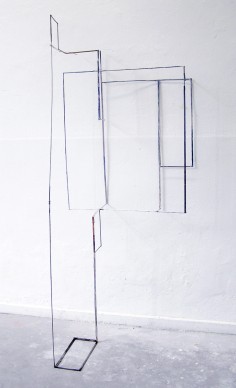sara barker
Сара Баркер
Intercourse
source: axisweborg
Sara Barker’s linear sculptures are made from a range of industrial and synthetic materials including aluminium, steel, cement, Perspex, ceramic and paint.
Thin frames of painted metal intersect and loop, their slender forms angled and curved. At first glimpse the works appear fragile and precariously balanced. However, each is carefully engineered and held together with just the right amount of rivets and bolts to make it stable.
Barker studied painting at Glasgow School of Art and is interested in the looseness and gesture of painting and drawing, although her process is one of reduction and economy. Working with large expanses of aluminium in the studio, she paints onto the surface with gouache, watercolour and oils, and cuts away at the material. Narrow strips of metal are then assembled into grid-like formations, the rigid structures often revealing flashes of blue, pink, green. In some works the painted surfaces have more prominence and there are larger areas of colour. Patches of canvas and filling compound add richness and texture.
.
.
.
.
.
.
.
source: saatchigallery
Sara Barker’s works don’t simply breach the boundaries between painting and sculpture, they are that boundary. Skeletal structures in aluminium and steel describe wonky rectangular shapes in the air in hesitant lines, as though uncertain of themselves; their forms are those of sketches, not sculptures. Their surfaces are then coated with layers of oil paint, gouache and watercolour in the blanched and airy palette of a landscape painting. And as landscapes do, Barker’s works posit painting as a thing to be inhabited, and draw on the tradition of inhabited rooms in the quiet modernist lineage of Bonnard and Matisse (one work is named after his 1916 painting ‘The Piano Lesson’).
Modernist literature, too, has long provided Barker with inspiration for her spindly spatial constructions: both the metaphorical and actual space of Virginia Woolf’s ‘A Room of One’s Own’ – the unfolding of a novel is, too, a kind of space-making – might provide discreet associations with her work. Yet Barker’s works refuse to cooperate with conventional categorization: these are the spaces between, like the gaps that separate words in a sentence. Their power lies in what they don’t quite say.


